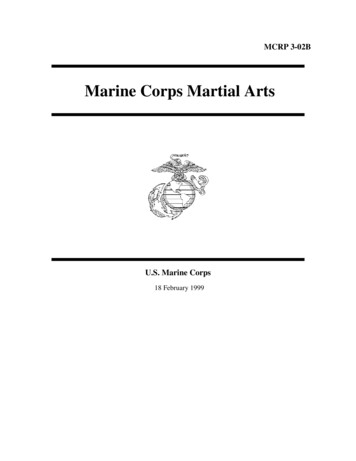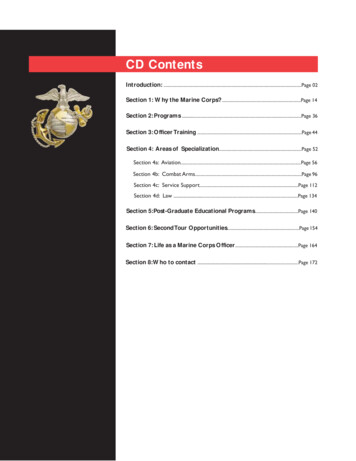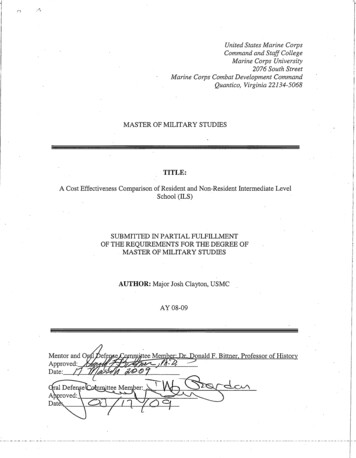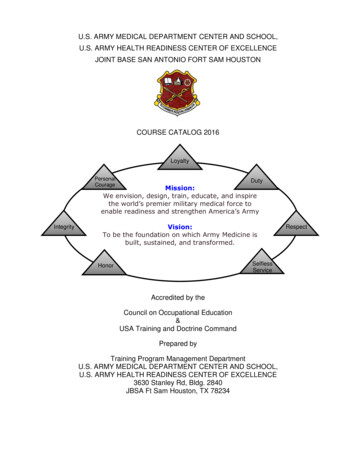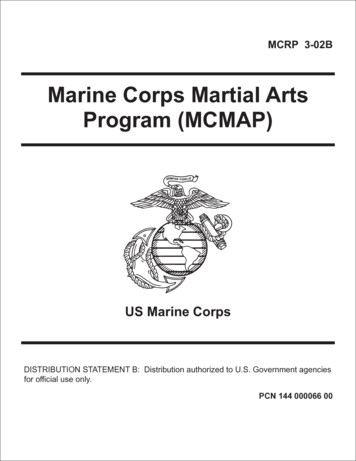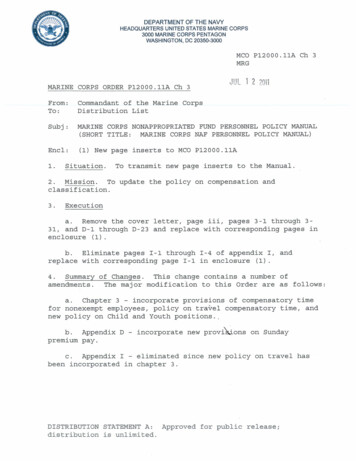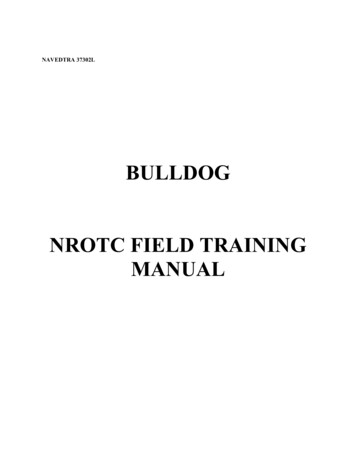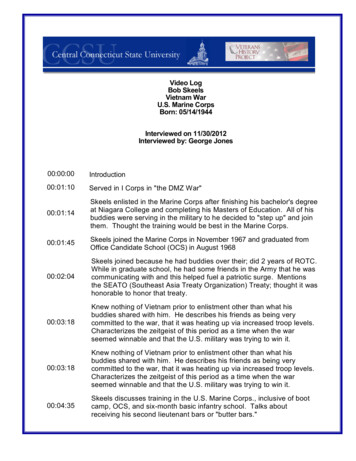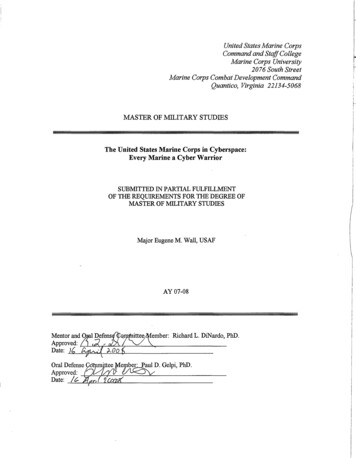
Transcription
United States Marine CorpsCommand and Staff CollegeMarine Corps University2076 South StreetMarine Corps Combat Development CommandQuantico, Virginia 22134-5068MASTER OF :MILITARY STUDIESThe United States Marine Corps in Cyberspace:Every Marine a Cyber WarriorSUBMITTED IN PARTIAL FULFILLMENTOF THE REQUIREMENTS FOR THE DEGREE OFMASTER OF MILITARY STUDIESMajor Eugene M. Wall, USAFAY07-08Mentor and 0Approved: 1 :.J.li2 :--J. .!.r-------'::::"-----.:oDate: .l.SL--!:: l-Oral Defense YV lfllilJolApproved: -- ::"L ---,f. .-I-.::----::--- --------Date: -!/:.::?:.t:.J.[L .L.! :.l- ---------
Form ApprovedOMB No. 0704-0188Report Documentation PagePublic reporting burden for the collection of information is estimated to average 1 hour per response, including the time for reviewing instructions, searching existing data sources, gathering andmaintaining the data needed, and completing and reviewing the collection of information. Send comments regarding this burden estimate or any other aspect of this collection of information,including suggestions for reducing this burden, to Washington Headquarters Services, Directorate for Information Operations and Reports, 1215 Jefferson Davis Highway, Suite 1204, ArlingtonVA 22202-4302. Respondents should be aware that notwithstanding any other provision of law, no person shall be subject to a penalty for failing to comply with a collection of information if itdoes not display a currently valid OMB control number.1. REPORT DATE3. DATES COVERED2. REPORT TYPE200800-00-2008 to 00-00-20084. TITLE AND SUBTITLE5a. CONTRACT NUMBERThe United States Marine Corps in Cyberspace: Every Marine a CyberWarrior5b. GRANT NUMBER5c. PROGRAM ELEMENT NUMBER6. AUTHOR(S)5d. PROJECT NUMBER5e. TASK NUMBER5f. WORK UNIT NUMBER7. PERFORMING ORGANIZATION NAME(S) AND ADDRESS(ES)United States Marine Corps, Command Staff College,Marine CorpsUniversity, 2076 South Street,Marine Corps Combat DevelopmentCommand,Quantico,VA,22134-50689. SPONSORING/MONITORING AGENCY NAME(S) AND ADDRESS(ES)8. PERFORMING ORGANIZATIONREPORT NUMBER10. SPONSOR/MONITOR’S ACRONYM(S)11. SPONSOR/MONITOR’S REPORTNUMBER(S)12. DISTRIBUTION/AVAILABILITY STATEMENTApproved for public release; distribution unlimited13. SUPPLEMENTARY NOTES14. ABSTRACT15. SUBJECT TERMS16. SECURITY CLASSIFICATION OF:a. REPORTb. ABSTRACTc. THIS PAGEunclassifiedunclassifiedunclassified17. LIMITATION OFABSTRACT18. NUMBEROF PAGESSame asReport (SAR)4219a. NAME OFRESPONSIBLE PERSONStandard Form 298 (Rev. 8-98)Prescribed by ANSI Std Z39-18
1Executive SummaryTitle: The Importance ofthe United States Marine Corps in Defending Cyberspace:Every Marine a Cyber WarriorAuthor: Major Eugene M. Wall, United States Air ForceThesis: The threats in cyberspace will hinder the Marine Corps from accomplishing itsfuture missions unless every Marine takes an active roll in defending the operatingenvironment of cyberspace.Discussion: Dr. Lani Kass best summed up the current state of military operationalrequirements when she said, "If we don't dominate cyberspace, we won't be able todominate air, space, land or sea domains." This statement drives home the point for theMarine Corps that in order to be the an expeditionary force in readiness, capable ofexploiting the efficiency and lethality ofthe Marine Air Ground Task Force (MAGTF),the Marine Corps must play an active roll in the DoD effort to dominate cyberspace.Future concepts for the Marine Corps rely on a secure cyber operating environment inorder to employ the MAGTF. The responsibility for defense of cyberspace, is not solelythe responsibility of organizations such as the Marine Corps Network Operations andSecurity Center, nor any other computer network control center. The responsibilityactually falls on every Marine to participate in order to ensure the MAGTFs freedom ofmaneuver in cyberspace, and deny adversaries around the globe their freedom tomaneuver. This study highlights the threats from cyberspace that will induce friction infuture operating environments. It is meant to provide Marines with just enoughknowledge to inspire them to consider the threat when planning and executing futureoperations.Conclusion: The threats from cyberspace are significant enough to hinder the MarineCorps' ability to accomplish its mission. It is the synergistic effects of every Marine'sactions in defending cyberspace that will allow for military dominance in cyberspace, andthus the dominance of air, space, land, and sea.
11DISCLAIMERTHE OPINIONS AND CONCLUSIONS EXPRESSED HEREIN ARE THOSE OF THEINDIVIDUAL STUDENT AUTHOR AND DO NOT NECESSARILY REPRESENTTHE VIEWS OF EITHER THE MARINE CORPS COMMAND AND STAFFCOLLEGE OR ANY OTHER GOVERNMENTAL AGENCY. REFERENCES TOTHIS STUDY SHOULD INCLUDE THE FOREGOING STATEMENT.QUOTATION FROM, ABSTRACTION FROM, OR REPRODUCTION OF ALL ORANY PART OF THIS DOCUMENT IS PERMITTED PROVIDED PROPERACKNOWLEDGEMENT IS MADE.
111IllustrationsFigure 1. Distributed Operations Unit Spatial Distribution26Figure 2. MAGTF C2 Illustration27
IVTable ofContentsExecutive SummaryiDisclaimeriiIllustrationsiiiTable of ContentsivPrefacevI. INTRODUCTION1II. WORDS MEAN THINGS2III. THREAT ANALySISThe Threat to National SecurityThe ActorsThreat of DisruptionThreat of ExploitationThreat of ManipulationThreat of DestructionThe Threat to DoD555778910IV. INFORMATION MANAGEMENTRelationship to Distributed OperationsRelationship to Operational Maneuver from the SeaRelative to Ship to Objective Maneuver11121314V. INFORMATION OPERATIONSOperational SecurityComputer Network Operation151618VI. CONCLUSIONS19Notes22Appendix A26Appendix B27Appendix C28Bibliography30
vPrefaceCyberspace has come to the forefront in the past decade as a medium that supportsthe global economy, facilitates socialization, and provides a means to broadcastinformation at speeds never before seen. It has also become a favorite battle ground forcriminals and terrorists. The Marine Corps is a target of malicious actions in cyberspace.Over the past year I have observed a full spectrum of opinions relating to the significanceof malicious activity in cyberspace and its relationship to the ability of the Marine Corpsto accomplish it's future missions. Opinions given to me about this topic ranged fromviews that cyber defense is the key to mission success, to the opposite end that claim thatcyberspace has nothing to do with finding, closing, and destroying an enemy, orpacifying the local population. I personally believe the answer lies somewhere in themiddle, but feel it is necessary that everyone has a role, and that everyone at leastunderstand their part in this effort. With no other compelling papers written for theMarine Corps on this topic, I felt compelled to write this and try to inspire thoseindividuals who do not believe they have a roll in the defense of cyberspace tounderstand the complexity and necessity of this mission.Through the course of this journey I received a lot of help from people at QuanticoMarine Corps Base. I would like to express my sincere appreciation to Colonel EricRolaf, Commander of the Marine Corps Network Operations and Security Center, and hisstaff, specifically Lieutenant Colonel Augusto Catta, Mr. Paul Skopowski, and Mr. DaveDean. Furthermore, I would also like to thank Lieutenant Colonel Steve Roberts andCapt Stephanie Arndt of the Marine Corps Combat Development Command for assistingin understanding the role of cyberspace in future Command and Control concepts.
VllREPORT DOCUMENTATION PAGEFORM APPROVED - - - OMB NO. 0704-0188runuc REPORTING BURDEN FOR TillS COLLECTION OF INFORMATION IS ESTIMATED TO AVERAGE I HOUR PER RESPONSE, INCWDING TIlE TIME FOR REVIEWING INSTRUCTIONS. SEARCHING E.'\'lSTING DATA SOURCES. CAnlERINO .\NO MAINTAINING THE DATA NEEDED, ANDCOMP1El1NG AND REVIEWlNO TlIECOLLECTION OF INFORMATION. SEND COMMENTS REO,\RDINO TillS DURDEN ES11MATE ORANY OTilER .\sPECTOFTIIlS COLLECTION OF INFORMATlON,INCLUDING SUGGESTIONS FOR REDUCING TIns DURDEN, TO WASIiINOTONHEADQUARTERS SERVICES, DIRECTORATE FOR INFORMATION OPERATIONS AND REPORTS, 1215 JEFFERSON DAVIS 1II01lWAY. SUITE 12().l, ARLINGTON, VA 2220:204302, AND TO TIlE OFFlCEOF MANAGEMENT AND BUDGET, PAPERWORK REDUCTION PROJECT (07l).J.(J188)WASIiINOTON. DC :20S031. AGENCY USE ONLY (LEA VE BLANK)12.REPORT DATE4. TITLE AND SUBTITLE3. REPORT TYPE AND DATES COVEREDSTUDENT RESEARCH PAPER5. FUNDING NUMBERSThe United States Marine Corps in Cyberspace:Every Marine a Cyber WarriorN/A6. AUTHOR(S)Maj Eugene M. Wall7. PERFORMING ORGANIZATION NAME(S) AND ADDRESS(ES)USMC COMMAND AND STAFF COLLEGE2076 SOUTH STREET, MCCDC, QUANTICO, VA 22134-50689. SPONSORING/MONITORING AGENCY NAME(S) AND ADDRESS(ES)SAME AS #7.8. PERFORMING ORGANIZATION REPORT NUMBERNONE10. SPONSORING/MONITORING AGENCY REPORT NUMBER:NONE11. SUPPLEMENTARY NOTESNONE12A. DISTRIBUTION/AVAILABILITY STATEMENT12B. DISTRIBUTION CODENO RESTRICTIONSN/AABSTRACT (MAXIMUM 200 WORDS)Dr. Lani Kass best summed up the current state of military operational requirements when she said, "If we don't dominate cyberspace, we won't beable to dominate air, space, land or sea domains." This statement drives home the point for the Marine Corps that in order to be the an expeditionaryforce in readiness, capable of exploiting the efficiency and lethality of the Marine Air Ground Task Force (MAGTF), the Marine Corps must play anactive roll in the DoD effort to dominate cyberspace. Future concepts for the Marine Corps rely on a secure cyber operating environment in order toemploy the MAGTF. The responsibility for defense of cyberspace, is not solely the responsibility of organizations such as the Marine Corps NetworkOperations and Security Center, nor any other computer network control center. The responsibility actually falls on every Marine to participate in orderto ensure the MAGTFs freedom of maneuver in cyberspace, and deny adversaries around the globe their freedom to maneuver. This study highlightsthe threats from cyberspace that will induce friction in future operating environments. It is meant to provide Marines with enough knowledge to inspirethem to consider the threat when planning and executing future operations.14. SUBJECT TERMS (KEY WORDS ON WHICH TO PERFORM SEARCH)15. NUMBER OF PAGES:Cyberspace16. PRICE CODE: N/A17. SECURITY CLASSIFICATION OF REPORTUNCLASSIFIED18. SECURITYCLASSIFICATION OFTHIS PAGE:19. SECURITYCLASSIFICATION OFABSTRACTUNCLASSIFIEDUNCLASSIFIED20. LIMITATION OF ABSTRACTIr-
1I. INTRODUCTION"We are in a world today where, in addition to the classical dimension of land,sea, and air, we have a virtual dimension called cyberspace."l These words echoedacross a Washington D.C. audience at the Center for Strategic and International Studies.The speaker was not representing a major information technology fIrm trying to explain anotional threat in order to sell a product. Rather, the speaker was Jaak Aaviksoo, atheoretical physicist and the defense minister of Estonia. His presentation andproclamation were based on practical experience. For three weeks in April and May2007 a cyber attack from outside of Estonia brought the nation to a standstill.Government operations were ineffective in their efforts to direct a rapid recovery fromthe attack. The two banks that held nearly 90 percent of the nations economy werebreached. The Estonian population felt the psychological impact of a war that producedno traditional casualties. 2Globalization in a post-Cold War era, aided by advances in informationtechnology, have expanded the requirements for national security beyond traditionaldiplomatic, economic, and military roles. Security concerns now extend beyond thephysical world to the nebulous world of cyberspace. 3In the 21 st Century a new medium for the global economy and security hasemerged and the United States military fInds itself at the forefront ofprotecting the newdomain. This new domain and battlefIeld is cyberspace. Cyberspace, however, is notsolely used as a medium to translate the global economy; it is used as a medium to enablethe warfIghting functions of the world's militaries.
2The United States Department of Defense (DoD) has already commenced militaryoperations in cyberspace. The United States Strategic Command (STRATCOM), withsupport from the military services and other national level agencies, is organizing aneffort to protect the United States from cyber threats. The mission associated with cyberdefense is nothing like the United States Marine Corps has encOlmtered in its history.Furthermore, conducting operations to defend cyberspace is not an explicit taskassociated with the mission of being an expeditionary force in readiness. With such avast commitment on the part of the DoD and joint community to defend cyberspace, it isimperative that we answer the question of whether or not there is a credible threat incyberspace preventing the Marine Corps from being an expeditionary force in readinessfor the future. Additionally, if there are threats in cyberspace challenging the ability ofthe Marine Corps from succeeding in its mission, what are the impacts of those threatswhy is it important to engage the threat? This paper will set out to explore thesequestions in order to illustrate the point that the threats in cyberspace will hinder theMarine Corps from accomplishing its future missions unless every Marine takes an activerole in defending the operating environment of cyberspace.II. WORDS MEAN THINGSBefore cyberspace became a military term it was introduced to the world in 1984by William Gibson in his book Neuromancer. 4 By the mid 1990's the DoD introducedthe term into its vernacular as numerous papers were written at Air University and theNaval War College on the potential for future military operations in cyberspace. In thesepapers it is virtually impossible to find a unified defmition of what cyberspace meant tothe authors. Today, the definition of cyberspace still varies depending on the reference.
3The DoD defmes cyberspace as, "the notional environment in which digitizedinformation is communicated over computer networks."s The United States Air ForcedefInition varies slightly. According to Air Force Doctrine Document 1-2 cyberspace is,"A domain characterized by the use of electronics and the electromagnetic spectrum tostore, modify and exchange data via networked information systems and associatedphysical infrastructures.,,6 The United States Marine Corps and Army do not have aformal defInition for cyberspace. 7The subtle differences between the defInitions are signifIcant. The fIrst is noted inthe characterization of cyberspace. The DoD defInition implies a medium that is not realcompared to the physical medium of the traditional land, sea, air, and space battledomains. The Air Force characterizes cyberspace simply as a domain. The AmericanHeritage Dictionary defmes a domain as a territory over which rule or control isexercised. 8Maneuver in cyberspace cannot be manipulated or controlled just as militariescontrol maneuver over geographic land. At this time it is easier to defIne the boundariesof space than the boundaries of cyberspace as we have physical laws that governmaneuver in space. The closest analogy to a physical domain resides in the equipmentseparating the edges of the various parts of the domain such as the web servers andfirewalls.The common use ofthe word network in both defmitions is awkwardlyambiguous. With no defmition of what a network is existing in any doctrine, the apertureis wide open for interpretation of where the limits of the physical domain intersect withthe virtual domain of cyberspace. One persoll may interpret the network as a system of
4systems that includes the people, hardware, computer software, and electronic nodes thatconnect points in order to share information. Another person may only consider thehardware and the paths to transmit information.On the surface the subtle differences may not appear significant. However whenforced to conduct an analysis of the friendly and enemy centers of gravity in cyberspace,these definitions need to be synchronized in order to detemline the correct vulnerabilitiesto either protect or attack a network in cyberspace.As previously pointed out, the Marine Corps has not yet published a definition ofcyberspace that fits the requirements of the Marine Corps' mission and capabilities. Dr.Lani Kass explained that cyberspace does not just mean computers. It also coverseverything from satellite communications to gamma rays to microwave technologies. 9 Inanother presentation Dr. Kass further described cyberspace as covering "almosteverything electrical or electromechanical, from the simplest direct-current applicationsto the slickest, fastest space-age GPS gadgets off to things that haven't been invented."l0This opens up the aperture to consider data flowing through fiber optic strands, satellitelinks, and copper wires. These items are all elements of the physical world. 11 For thepurposes of this paper the DoD definition, taking into consideration the limits highlightedby Dr. Kass, will form the basis for all Marine Corps discussions. The term computernetwork will be defined as any device that transmits an electronic or digital signalcontaining information to influence actions of people or machines. This allows for notonly the inclusion ofpersonal computers, but also radio networks, aircraft data links suchas Link 16, and other analogous systems.
5ill. THREAT ANALYSISThe Threat to National SecurityTwo decades ago a person could fmd American streets speckled with telephonebooths and mail boxes. To deposit or withdraw money a person had to go to a bank andobtain assistance from a bank employee. To send a note or letter a person had to sit downwith a pen and paper to write a letter and drop it in a mail box so it could be delivereddays later to its recipient. Look anywhere in America today and the phone booths aredisappearing as people use their personal cellular phones. Bank tellers are not necessaryas bank customers do their banking on the Internet or use Automated Teller Machines.E-mail is replacing mail delivered by the US Postal Service. These points demonstratethe difficulty in imagining "a world without instant communications and the freedom toaccess goods, services, and information at will.,,12 Each one of these elements becomes avulnerability to a potential cyber adversary. A controlled demonstration of thedestructive capability of a cyber attack was conducted by the Department of HomelandSecurity. In this demonstration researchers launched an experimental cyber attack on apower generator causing it to self-destruct. The results ofthis experiment alarmedfederal government and electrical industry officials about what could happen if such anattack were conducted on a larger scale. 13The Actors"America is under widespread attack in cyberspace," according to Gen James C.Cartwright, commander USSTRATCOM. 14 United States Representative MichaelMcCaul was quoted in a Houston Chronicle interview as saying, "My view is that sinceSeptember 11 we've been very focused on the physical threats, as we should be, but very
6little attention has been paid to the virtual threats-the cyber-attacks to our networksystems ranging from mischief to criminal acts or espionage." Representative McCaulwent on to say, "With the United States and 24 other countries developing programs towage war using computers, attacks by foreign governments or terrorists on sensitive U.S.government, critical infrastructure and fmancial network systems cannot bediscounted.,,15"Our freedom to use cyberspace is threatened by actions of criminals, terroristsand nations alike.,,16 Threats to cyberspace come from state and non-state actors. TheInternet allows small groups of non-state foes to finance, plan, supply, and executeterrorist operations globally with little regard to borders, laws, and government. I7 Chinais the number one nation leading global efforts in cyber warfare. I8 As recent as the fall of2007 cyber attacks traced to Internet addresses in China were reported by the Departmentof Romeland Security (DRS). The sophisticated fall 2007 attack involved approximately1,100 attempts to steal data from the Oak Ridge National Laboratory in Tennessee. Theattack was classified as a phishing attack I9 where employees were sent two e-mails withlegitimate subjects and content regarding a scientific conference and the other a FederalTrade Commission complaint. When the recipient read the e-mail and opened theattached documents an embedded program copied and forwarded information from thecomputer network to remote locations.2oA token non-state actor operating in cyberspace is Al Qaeda.2 1 The Internetbecame the medium of choice for Al Qaeda to coordinate its activities, including the 9/11attacks. 22 This exemplifies the point that the Internet is a Computer MediatedCommunications platform used for recruiting, training, funding, targeting, information
7operations, and intelligence collection.23 Their coordinating measures went beyondwebsites and e-mail to the use of Internet telephone services to communicate with terrorcells overseas. The Internet provided them a place and a means to expand their influence,social network, and operational reach. 24 These same capabilities will be discussed laterand illustrate that the Marine Corps has the same capabilities to support their operations.Threatofl) ruptionParamount to defending cyberspace is preventing the disruption of the flow ofcommunications, economic transactions, and public necessities that foster civilized ordersuch as public utilities. This threat may be to the United States, or any other nation thatthe Marine Corps happens to be operating in. Much of this disruption would be felt as aneconomic anomaly; however, the economic stability of a nation is proportional to amountof national civil obedience.For the United States Marine Corps the disruption of military communications intimes of conflict presents the potential loss of life or aborted military missions. 25 Theprobability of this type of threat cannot be taken lightly as the means to engineer anddeliver the threat exists and is becoming easier to exploit.Threat ofExploitationExploitation of information from cyberspace may not strike individuals as aserious matter considering the fact that" people use cyberspace daily to distributeinformation to global audiences. This paper is prepared using a significant amount ofinformation obtained from cyberspace. This information is exploited to make a specificpoint. Not all examples of exploitation in cyberspace are as benign. For example, in1999 a series of structured, persistent, and purposeful probes into university, government,
8and private sector computer systems in the United States, allegedly originating in Russia,resulted in the theft of considerable amounts of unclassified, but sensitive information.Code name Moonlight Maze, this operation went on for years before it was detected. Theattacks were not disruptive, "but dangerous in [the] aggregate.,,26 James Adams, ChiefExecutive Officer of Infrastructure Defense Incorporated testified before the SenateCommittee on Governmental Affairs that regarding Moonlight Haze, "The value of thisstolen information is in the tens of millions-perhaps hundreds of millions-of dollars;there's really no way to tell. The information was shipped over the Internet to Moscowfor sale to the highest bidder. ,m This example of the uncontrolled release of informationfor the benefit of a state or non-state actor is significant. Just as significant is themanipulation of data from cyberspace to aid the actor.Threat ofManipulationManipulation of information in cyberspace may not be an obvious threat tomilitary operations. Placing historical events of information manipulation in contextmakes this an obvious threat. In an cyber attack launched by pro-Palestinian "PakistaniHackerz Club", members defaced the Web site of the American Israel Public AffairsCommittee (AIPAC); they also downloaded 3,500 e-mail addresses to which they sentanti-Israeli messages, and 700 credit card numbers belonging to members who had madedonations to the organization and promptly published them on the Internet. 28 While thiscase may have only served to make a public statement by an independent organization,the social and political impact in regions ofthe world already socially, politically, andculturally stressed may be enough to trigger second and third order reactions that mayprompt a United States military response. As the force in readiness, a Marine Corps
9response is an option to the National Leadership to stabilize a region affected by such anattack.Threat ofDestructionThe threat of physical destruction as a result of operations in cyberspace was onceconsidered science fiction and the plot for Hollywood blockbuster films.l 9 The reality isthat physical destruction as a result of operations in cyberspace has already beendocumented and will become more sophisticated with time.Kinetic attacks against power and water distribution networks, sanitation systems,and information networks such as television and radio outlets have been routine targets inthe conduct ofland-based maneuver warfare. Non-kinetic destruction on these sametargets are now inflicted via operations in cyberspace. An example of a low intensitynon-kinetic destructive operation in cyberspace was the May 4,2000 release of the LoveBug computer virus by a 24 year old Philippine man who allegedly developed thepassword-stealing virus as a school project. 30 The virus not only stole passwords, itdeleted files on computers, replicated itself, and used the individuals e-mail address bookto distribute itself to every person in the address book. The virus attacked computersworldwide, including computers within the Department of Defense, Department ofCommerce, Department of Justice, Department of Health and Human Services, theNational Aeronautics and Space Administration, among many others. 31Kinetic military operations are no longer required to disrupt critical infrastructuresuch as power, transportation, and water systems. The Central Intelligence Agency hasrecently confmned computer hackers have "in at least one case, caused a power outageaffecting multiple cities.,,32 This revelation comes only months after the Department of
10Homeland Security leaked the report on a controlled experiment where a staged cyberattack demonstrated how easy it is to destroy a power grid. Once access to a computercontrolled power grid was gained, a command was sent to one of the generators on thegrid. The command directed that the engine increase its revolutions per minute so highthat the generator self destructed within minutes. 33 Considering the fragility of civilinfrastructure in countries such as Iraq, the threat to non-kinetic cyber attacks producingkinetic results that threatens national security in areas where the Marine Corps isoperating requires attention. 34The Threat to DoDWhile the nation is at war in cyberspace, so is the DoD. General JamesCartwright, vice chairman of the Joint Chiefs of Staff, cited statistics on the number ofcyber attacks in fiscal year 2007. According to General Cartwright, there were, "80,000attempted computer network attacks on [DoD] systems.,,35 He went on to say that someof these assaults "reduced the U.S., military operational capabilities.,,36 In April 1997 theChinese government formed a cyber hacker army unit who trains specifically for cyberwarfare. It has been reported that the Chinese military hackers have mapped out adetailed plan to neutralize U.S. [aircraft] carriers. 37This is not the first time that China has been implicated in cyber threats to theDoD. USA Today reported on a DoD program entitled Titan Rain. 38 TIns programinvolved a group of researchers in the Guangdong province who coordinated cyberattacksagainst systems at NASA and Sandia National Laboratories. 39 The Department ofNavywas a target of a cyber attack, presumably launched by the Chinese, in fall of 2006. Theattack was severe enough that the Naval War College was forced to disconnect from the
11Internet for three weeks. Investigators suspect the attackers targeted unclassifiedinformation on war games that were being developed at the school. 40Relying on a portion of the definition of cyberspace that includes the physicalmedium that information flows through, the physical security of our satellites thatfacilitate cyberspace operations cannot be ignored. China poses a threat to satellitesecurity as was illustrated by their successful demonstration of their anti-satellite missile.General Paul Hester, former commander of Pacific Air Forces said that the anti-satelliteweapon demonstration is a concern to the US military because of the potential disruptionof military communications with commanders in Japan and South Korea. 41 Thisstatement highlights a critical vulnerability to the US military and drives a requirementfor DoD action to secure all aspects of cyberspace including the nodal networks in spacethat enable the cyber battlespace to exist.Investigations into thecyber attack against Estonia have concluded that Russiamay have been responsible for the attack. Moscow denies the charge. The BritishBroadcasting Corporation (BBC) reported that many of the attacks came from computershosted by Russian state computer servers.42 This demonstration of Russian capabilityhighlights an additional threat to the DoD if Russia decides to add this capability to itsdefense strategy.IV. INFORMATION MANAGEMENTThe DoD threats from state and non-state actors knows no boundaries. The globalnature of information networks yields a ripple effect across the globe when any part isperturbed. An attack on the DoD as a whole is an attack on the Marine Corps as anindividual Service. A credible and valid threat exists in cyberspace that threatens the
12Marine Cor
the Marine Corps must play anactive roll inthe DoD effort to dominate cyberspace. Future concepts for the Marine Corps rely ona secure cyber operating environmentin orderto employ the MAGTF. The responsibility for defense ofcyberspace, is not solely theresponsibility oforganizations suchas the Marine Corps Network Operations and Security Center .


